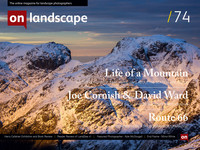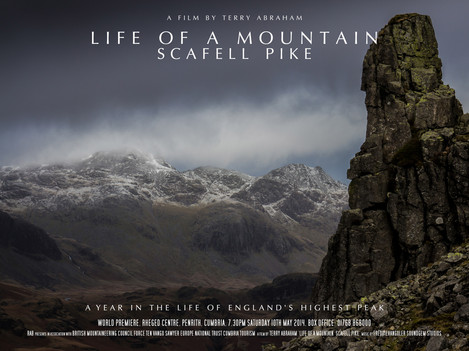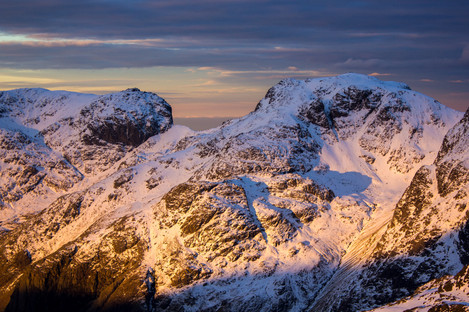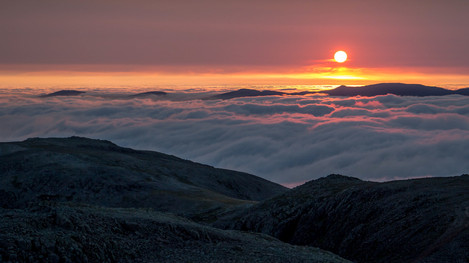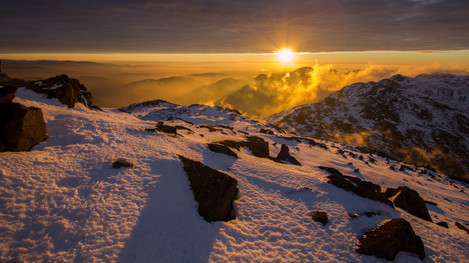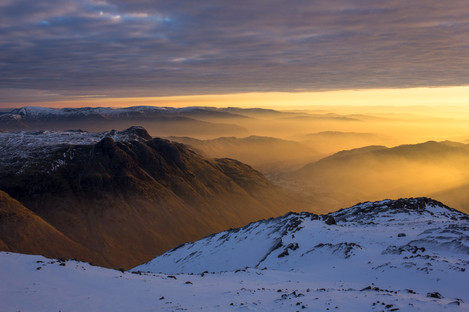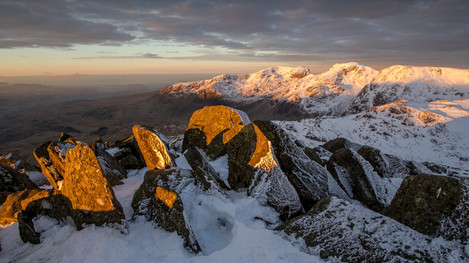Author of a video on Scafell Pike in the Lake District

Tim Parkin
Amateur Photographer who plays with big cameras and film when in between digital photographs.
On Landscape have helped the Rheged to put on an exhibition of Lake District photographers and also a talk by David and Angie Unsworth and a workshop by Mark Littlejohn to coincide with the launch of Terry Abraham's movie "Life of a Mountain", a full feature about Scafell. We talked to Terry about his project and asked him how he the whole thing started.
Tim: We’ll start off asking you a bit about your background as a photographer film maker. What came first for you? I’m presuming it was the outdoors before filming and photography.
Terry: I’ve always had an interest in film and video. As a young man, I always daydreamed of producing my own films one day but such is life and it never really came to fruition but that interest was always there. I’ve always had a love and passion for the outdoors. A few years ago, I bought a cheap camcorder, started taking it out on my camps up the hills, built up quite a large following on the likes of You Tube and it’s really thanks to modern technology and the Internet that my career’s been born from there in terms of getting the interest. I won a couple of amateur film competitions. I started the video making side of my trips and capturing the hills but more seriously and then I got made redundant in a job I was doing in IT. At that point, I was moonlighting at weekends producing short videos of the Peak District for various tourism bodies and I thought, I’m going to go for it as a full time living. Invested in better and more professional equipment in terms of the craft of making videos and it was very hard, it was a struggle but I got through the first year. They always say the first year in business if you’re still going, you’re onto something. If you keep going after two years, you’re definitely onto something and also it’s going to grow and that’s exactly what happened. It’s all led to me producing this film about the Scafell, it’s a long held ambition of mine where I could produce something I wanted to see not somebody else wanted to see, like some clients I work with. The photography came out a year or two ago, I’ve only started taking the photography seriously. Some friends I speak to on Twitter are saying, “You’re taking some fantastic shots on video, why are you not taking photos?” and I’m going, “I don’t have a DSLR or anything like that,” so I’ve invested in a DSLR and now, about a quarter of my income comes from the photography. I don’t put the images out online on the likes of Alamy or anything like that. I’m quite fortunate in that I get approached by companies and then commissioned to do photos. Anything I put out online gets picked up my magazines and they get in touch and so on.
Tim: That’s where the money comes from, commissions, with the landscape photography.
Terry: Yeah, that’s something I learned. A lot of what I’ve just talked about has been a very steep learning curve for me. I’m not formally trained with anything like this at all. I’ve taught myself. I have to say I was considered a talented artist as a young man and I was an illustrator till my mid-twenties and I suppose I’ve got a natural eye for seeing a picture. In a roundabout way that’s what shows through the work I do, particularly with videos, it’s always about that composition, getting that picture. But whereas I could create something as an illustrator or change things or arguably some people do with Photoshopping images, with video it’s all about being in the right place at the right time. I can’t do anything with the image afterwards.
Tim: No, very difficult, not like what you can do with Photoshop, video hasn’t quite got to that stage yet, fortunately I would say. But you’re not from a mountainous area; Nottinghamshire is not exactly full of the peaks.
Terry: No, it’s quite flat round here.
Tim: And your background if you’d been out travelling, you’d have been interested in going round Sherwood Forest I presume, like it says on your ‘About’ pages on your favourite locations.
Terry: Yeah, that’s absolutely correct. It was my grandfather’s love for the outdoors. He was a farmer and gamekeeper and he’d often take me out on hikes and we’d camp out in the woods overnight watching badgers and foxes. My grandmother had a big interest in culture and history so they both had a profound influence on me in that respect, in shaping my view of the world we live in. They were immigrants as well, they weren’t born here. They came here after the War. Not long before I got made redundant, I had a health scare, a suspected heart attack and that reignited my passion to the fore for the outdoors and particularly here in Britain. I felt like there are lots of places I want to see and visit and camp out and make the most of it because life’s just too short. While some would say it became an obsession of mine in truth, it doesn’t feel that way for me and just that obsession, that passion for the outdoors, the likes of Twitter, the You Tube stuff, it’s all come together all at the same time to put me where I am now so I do feel very fortunate and very grateful for the followers I have that have put me where I am today. It’s encouraging for me as well how they enjoy the sights I see and share.
Tim: Had you travelled before to the Lake District and Scotland?
Terry: Yeah, I did go out but not as often as I’ve done in recent years. Forget what I do now in my work but as a hobby, it’d be as often as possible. I’d work extra shifts at work so I could earn the hours which would then give me more free time off.
Tim: Was that mostly in the Lakes?
Terry: Yeah, mostly in the Lakes. I spent a lot of time in the Peak District and Snowdonia. There are lots of other places I’ve not been to. I’d like to. I’m recently spending a lot of time in Scotland but my heart really lies in Cumbria. I don’t want to say the Lake District because it’s a cliché but it’s the whole county, I love all the aspects of the county because you’ve got the Howgill Fells as well and the Northern Fells, the coastline, the Southern Lakes with the limestone country and the forests. It’s just something there. I often joke I was probably born a shepherd in a previous life because of the time I spend out on the Fells but it’s just there in me. As much as I love other places and they’re just as spectacular or arguably more spectacular, there’s just something about Cumbria that really pushes the buttons for me. That was one reason why I wanted to do this film about Scafell.
Tim: How do you go from having a health scare and then deciding to do something full time, to deciding it’s going to be about Scafell?
Terry: They were all like regular corporate and tourism videos that I was doing initially, bread and butter, I was just getting my foot on the ladder on this new career I was on. But where the idea of the Scafell film comes from, it’s really with a frustration that we never see much of the British countryside looking spectacular on the television or on DVDs you get in shops. It’s like the crews had turned up because they’re on a daily or hourly rate, they get the shot done and then they go home and that’s the Lake District. Don’t get me wrong, it does look beautiful whatever the weather and it can look nice but as a backpacker, as a wild camper, I know it can look a million times better. I see these sights from my tent on the Fells. Born out of that frustration is what led me to do this Scafell film, I wanted to show the Scafell through the seasons looking at its best and worst. But with my interest in history and culture as well and people, I wanted it to be as much about the people that live and work around the mountain as well and play on there because people have arguably shaped the mountains that we see today in the Lake District, sheep farming for example. So it’s something I always wanted to see because it’s just not out there. Recently I’ve been working extremely hard doing lots of night time laps of the area. You see that two a penny on these videos on You Tube or in California, the lucky beggars have got a lovely dry eyed desert to go out and see billions of stars. We don’t really see that here but we do get some nice dark skies. I can’t think of any particular productions where we’ve seen lots of night shots of places like the Lake District and that again I’m keen to get into the film and why I worked hard producing those night time lap sequences is because it’s another aspect of the area that’s stunning. It’s not just beautiful in the day; it’s beautiful at night as well when you see the Milky Way coming over. Again I suppose I’m revealing that passion and love for the area because I want to inspire and share this with people so it enlightens them, makes them wish to care and protect the area and more importantly, visit the area and look at it in a different way. If they’ve not been there before, they may want to go after seeing this.
Tim: Here’s a question for you. Scafell is notoriously difficult to photograph and you see very few photographs that get a good representation of what it’s like. I can think of a handful I’ve seen and I’ve seen a lot of people trying. If you’re going to choose somewhere for a video, why Scafell over other possibly more attractive options?
Terry: I disagree with that. I think the Scafell are photogenic. It depends where you go. A lot of people don’t wander far from the beaten path. There’s Yeastyrigg Crag which is on Esk Pike that gives you this formidable full on view of the Scafell on the Upper Eskdale side. It looks brutal. I often compare the Scafell as the ugly prince with the Queen that is Snowdon and the King that is Ben Nevis. The obvious ones from Hardknott and so on but you get this amazing view of the Scafell where it does look like a wild large mountain. High Gate Crags which in Upper Eskdale, there’s a real sense of isolation and being remote there and again it affords a fantastic view of the Scafell, a much more intimate view. However, when you go to the Wasdale side, it does look like large grassy hills with some craggy knobs on the top, totally different character and it’s often that side where you see all the photos of the Scafell and not so much the wild side. And that’s because it’s easily accessible from the road and people think the usual shot with water there in the same scene to frame the shot. But also you have to bear in mind that the weather plays a large part in the view of the area, the whole massif but also where the sun sets. Generally through the summer months, the warm dry months, spring and summer to early autumn, the sun sets along the line of the Wasdale Valley. It lights up that side of the Scafell and it can look very lovely and pretty, particularly the Screes nearby which all light up red in the late autumn because the sun’s setting in perfect alignment with the valley. That’s really rather exciting, there’s not many valleys you get like that in mountainous areas. When you get to late autumn and through the winter and early spring, the sun sets on the other side of the Scafell where it lights up Eskdale and lights up all the crags and knolls of the Scafell on that side, the wild side as I like to call it. Again, that’s completely different and it’s just as spectacular. If you’re on the other side, you’re dark. Unfortunately, it’s hard to get dawn shots. It tends to be early winter where the Scafell can look best at dawn because the sun tends to rise in alignment with the Crinkle Crags and as it creeps over the gap, the cull between Bowfell and Crinkle Crags where three tarns is, that cull thankfully gives enough dawn light to light up the majority of the Scafell on that side, that facet of it. I suppose in a roundabout way if you want it nice and easy, it is hard to photograph but if you persist and think outside the box, it’s easily achievable.
Tim: Do you think this is one of the downsides of the Lake District representation in landscape photography, the fact that all the photographs are taken from places within a mile at the most from a car park?
Terry: Yeah, absolutely. I can only think of a couple of photographers I know well in Cumbria base that actually get away. Most don’t walk more than a mile from the car. These guys camp out like I do. It’s their love and passion for the area and they get some amazing photos of the Scafell and the Lake District at large. They’re doing much the same as me but sadly, we’re a minority. I go out in all seasons. I’ve camped on Bowfell summit. It’s a rocky place, you can’t always put a tent there but in the height of winter, there’s lots of deep snow so you can get a tent up there. Sub-zero temperatures, I’ve encountered –18 and –19 wind chill up there, absolutely freezing but it was well worth it for some of the shots I got. I’m a crazy minority breed in that respect to most people but it’s just normal to me.
Tim: Have you been wild camping before you were doing the video?
Terry: Yeah, that was my hobby, backpacking in general so the interest came from that with video and everything else.
Tim: When you’re going out with your video, I’ve wild camped with my large format gear and it ends up quite a hefty collection of equipment by the time you’ve finished getting everything in a pack. How do you travel? Do you typically go out with a tarp in the summer or are you still a tent...?
Terry: I switch about. A tarp in the summer or a bivvy but when it comes to winter, it’s a tent every time. You get a bit more shelter. Arguably a bivvy will be just as good because it’s a bit more bomb proof wherever you can lie down and feel you can sleep the night, a bivvy will go there. With tents, you have to think carefully where you’re going to pitch it, is it quite sheltered.
Tim: It’s a long night in a bivvy though.
Terry: I get a thrill from that sense of exposure to the outdoors; it makes me feel much more in tune with the area, the sight and the sounds. I don’t particularly enjoy being cooped up in a tent because you’re cut off from it all. But a tent’s handy as well; I may sometimes base camp so I’ll make a camp and then go from there to save a bit of weight on my back. At the moment, this winter my pack was in excess of 30 kilos and that’s made me think very carefully on the kit I take and why. With regards to photography, I’m a big fan of these mirrorless cameras now.
Tim: Are you using things like the Panasonics?
Terry: No, the one I’m using at the moment, I chop and change my mind quite a bit, but the one that’s done me fine and I really enjoy using but I’d prefer a few more features on it is the Canon EOS M. It’s the only mirrorless camera they do but it’s tiny, it’s the size of a compact but spec hardware wise, it’s essentially the same as their mid-range DSLRs.
Tim: Incredibly cheap at the moment, I saw someone get one for £200 at a photography show.
Terry: Exactly. I still have a DSLR as well because with the mirrorless camera, you don’t have the viewfinder which is a bit of a pain sometimes because you have to rely on the light view screen. You can use Canon lenses with it but it defeats the object of using a mirrorless camera because it becomes a lot bulkier. Their own specific mirrorless camera lenses are not ideal really for photography when it comes to focus. You can’t see your focus numbers on the lens, I’m mimicking it already, you have to look through a viewfinder but you can’t do that on the Canon EOS M which is annoying so I do flip between the two. It depends how much kit I’m taking and why I’m on the trip so if I’m taking not as much video kit as normal, then the DSLR comes with me. If I’m taking a lot of kit with me, then the EOS M comes with me.
Tim: So you use a 5D for the video?
Terry: I did have one and I got rid of that, I’m using a 600D at the moment. I’ve been using the 600D primarily for time lapse, not really for the photography although if it’s all I have with me, then I will use it if there’s a shot I’d like to take a photo off. The priority is the video.
Tim: Do you take out sliders and things like that as well?
Terry: I used to take filters but I don’t bother now.
Tim: Sorry, sliders.
Terry: Yes, I do, it’s a professional 3 sensor video camera you use. Sadly DSLR video’s not very good. I know it’s all the rage at the moment and it’s great for online use but when it comes to DVD and TV or even where the Scafell film’s being shown on the IMAX screen, that’s where the shortcomings reveal themselves. You get a lot of codec fizz noise in the image.
Tim: Which camera is that?
Terry: If you use a DSLR for video, I don’t, you have more codec issues. It surprises lots of people when I mention it to them but 90% of DSLR don’t actually record true 1080 HD video, it’s a few lines less and of course it’s compressed and then you get a codec fizz in there. So I use a dedicated three chip professional video camera which is not a Canon, it’s a Panasonic. And it’s bulky and heavy but ensures I get the images I’m after and it has a very good wide dynamic range on it for a video camera.
Tim: That’s what you need for some of the shots I’ve seen you getting.
Terry: Yeah! I’d love it to be much better. A DSLR does afford a better wide dynamic range; it’s just all the shortcomings you get with that in terms of video. They’re not quite there yet. I’d love them to be because they’re smaller and lighter to carry but there are other things I have to consider as well. Sound, for example, is equally if not more important quite often than the actual images you’re capturing. DSLRs you’ve got your shortcomings there on the sound. You need dedicated audio recorders and it all adds more bulk and expense, where my dedicated video camera it’s all there built in.
Tim: I just do a bit of amateur video now and then and I ended up spending about £2500 on my audio gear and about £200 on the camera. You can save money on the video gear if you can compromise slightly but you can’t save money on the audio stuff.
Terry: But for online use, there’s nothing wrong with DSLRs and a relatively cheap microphone, it does the job but that’s been a steep learning curve for me in the last couple of years. I can’t do that for when stuff’s going on DVD or in cinemas, it’s got to be much better.
Tim: Out of interest on the sound side, the one thing most people get when they go out and do a video on the side of a mountain is wind noise, regardless of what they use. What’s your recommendation for trying to get some decent recording when you’re in the inevitable Lake District gale?
Terry: Again, this adds more bulk but not so much the weight, I have to add, I use a large Blimp. It’s just a large case; the microphone sits inside that on a suspension system so there’s a filter over the microphone that should cut out a bit of noise but not too much. The Blimp itself should cut out quite a bit of wind noise and on top of that, I put a furry dead cat, as they call them. That keeps the wind out and it surprises you how good the sound is. The wind just sounds like a deep breeze.
Tim: Do you know the Unsworths, David and Angie? They do recording now and they introduced me to the Blimps and they were very impressed with the sound quality.
Terry: I use it all the time now, unless it’s a nice day and then it’s fine. When I’ve interviewed people out on the Fells, normally I would wire them up with a tie clip mike but that has limitations if it’s going to be windy. If it’s going to be windy, the Blimp comes out instead, or I’ll use both just as backup and then I can work with both when I get back home.
Tim: You can mix some ambient sound in because the tie clips are quite tight sometimes.
Terry: Yeah, that does make a difference. If I’ve not used the Blimp, I’ll use the internal microphone, the video camera, but that’s not always ideal anyway. The quality on there is not particularly great but it’s good enough for ambient stuff if somebody’s talking through a tie clip mike, you won’t really notice.
Tim: Getting away from the technical side of it and back on the hill again, what do you compromise on when you’re out because of the weight? Do you compromise on your camping gear or do you always make sure you’re fairly comfortable?
Terry: That’s a tricky one. My base weight for my camping gear is not even four or five kilos. It’s a lightweight tent, it’s all top end gear, I’m quite fortunate that I bought some of this stuff myself the last few years but also the sponsors that are involved with the film produce good kit so they donate kit to me enabling me to carry on doing the film. So I’m quite lucky in that respect. With the tent, the sleeping bag, a decent mattress to keep me warm and comfortable ... I need a decent mattress because I’m going to be out for nights and nights, days on end, I need my sleep. I need to get a good night’s sleep to rest and recover or whatever the terrain and the weather’s throwing at me, so I don’t compromise too much on that front but I probably do with food. I don’t really take nice tasty warm meals with me, I’ll take things like dried fruit and nuts, chocolate drinks so I’m getting my nutrition, all my vitamins and minerals and my calories but it’s not exactly something I look forward to at the end of a hard day’s slog when I want my steak and chips or anything really that would be nice and warm inside me! But instead, I’m munching on dried fruit and nuts. So I probably just compromise there more than anything else.
Tim: How many days do you reckon you’ve spent on that mountain to try and get the footage you needed?
Terry: I’ve not been counting, let’s put it that way! I often get joked that they should do a Council tax ban for wild campers now with the amount of time I’ve spent out on the Fells in a tent! I’ve spent more time out on the hills than I have in my own bed at home so it’s a lot and it’s not all good either. There’s been many periods where I’m cooped up in a tent all day or on and off, mostly in a tent for two or three days because of the weather. I’ve got to take the rough with the smooth. I’m not a stubborn minded person but I’m bloody minded when I want to get a certain shot of the Scafell so I’ll often wait and wait for two or three days before thinking of giving up and moving on. Or I repeatedly go back to the same place chasing that special view that I want to capture. Eight times out of ten, I get it but eight times out of ten most of the video I capture is not planned anyway; it’s just what I see as I’m out walking and camping.
Tim: That was going to be one of my questions. A lot of photographers like to try and plan their shots in advance and my experience has been that some of the best moments just happen and you need to be ready for them. Has that been your experience?
Terry: Yeah, absolutely which is why I say 80% of what I’ve captured has not been planned at all. The simple reason for that is we can’t control the weather or the light or the air clarity we’re going to see. We can’t control the colour of the land in terms of the seasons. You’ve got to go with the flow and that’s how I am when I’ve been filming people out on the Fell, that go with the flow. There’s not too much of a script. There’s a rough outline of what I want them to talk about but I go with the flow and it’s much the same with capturing the images of the Scafell because I go with the flow. I have a little list of what I’d like and I’ll be mindful of that and keep aiming for it. If I don’t get it or I’m not happy with the shot I’ve got I might try to capture it again but it’s all about being out there in that moment.
Tim: The premiere is at the Rheged and I presume you’re getting pretty close to finishing the editing. Have you started thinking about what to do afterwards or are you just going to take a bit of a break to recoup?
Terry: I can’t afford to have a break, to be honest, I’m on a very low budget for this film and I’ve invested a lot of time. It’s taken over my life and taken quite a bit of my money as well. I didnt want to start working again straight away but the projects I’ve got lined up for this year are nowhere near on the scale of what I’ve been doing with the Scafell or as ambitious. Deliberately so because it’s easier work and I need a rest. That’ll be my break, just easier work, still working hard but working on this Scafell film has really knocked me for six. Physically, my body’s going to be thankful when it’s all over but in my heart, I admit I think I’m going to be really rather sad because of all the friends I’ve made there, getting to know the area much more intimately than I could possibly have ever imagined before starting on this project. The stuff I’ve got lined up, I’m doing a backpacking DVD with Chris Townsend in the Lake District, another Lake District based DVD with Mark Richards who’s the author of the Lakeland Fellranger series books and friend of Alfred Wainwright. And I’ve got some other jobs as well, just regular bread and butter work but nothing lined up now that’s on the scale of what I’ve been working on with the Scafell.
Tim: So theoretically if you were to do another one or a couple if it were a series, what other Fells would you choose?
Terry: Originally I wanted to call this ‘Portrait of a Mountain Scafell Pike’ but if I remember rightly, there’s a copyright on that so I changed it to ‘Life of a Mountain.’ I originally envisaged a series, the series being Scafell Pike, Snowdon, Ben Nevis but I didn’t want to run away with myself because I’m not sure how people are going to react to the film. It’s all subjective but if it proves popular, then great and I’ll seriously think about doing another one. Whether it would be Snowdon or Ben Nevis, I don’t know. My heart says Helvellyn; I’d like to do Helvellyn.
Tim: There’s a lot of life there.
Terry: But my brain is saying maybe go for Snowdon and leave Ben Nevis till last but I’m torn. I’d like to do one about Helvellyn personally and if I was, I would start on that late this year in the winter and carry on with that. We’ll see, it all depends on how well the film’s received. Thankfully, I’ve done some test audience stuff and they’re thrilled, it’s exceeding a lot of people’s expectations and I’m pleased with that because even though I do these little PR shorts for social networks, I’m deliberately holding back the true scale and depth to the film. There’s a lot going on but it’s not as in-depth as I’d like it to be because it’s only two hours. I could’ve done it as a series.
Tim: Director’s cut coming?
Terry: No, the two hour cut is the director’s cut. I really struggle to get everything in that without spoiling it with its emotive power. I want to strike the balance between it being a spectacle of the mountain through the seasons but equally about people, stories and their experiences. I was a little conscious about getting that balance right but thankfully with the test audience stuff, they’ve given the thumbs up. I don’t want to sound like I’m boasting about it but I’ve been absolutely over the moon with the feedback, it’s been such a thrill that it’s touched people deeply. Some people even said they shed tears and that astonishes me, stuff like that because I’ve become immune. I’ve seen the footage over and over again. Anything involving people might be quite emotionally moving, I’m not seeing that, I’m immune or whether a particular shot of the landscape or sequence I’ve put together is moving for people, it’s all lost on me.
Tim: It must be quite sad because I get this with my photography at times. You never have the effect that you would like your audience to have on yourself, you never see the picture as a stranger would see it.
Terry: No, and I get a thrill from that. I recently showed a selection of people on Twitter a ten minute clip from the winter chapter in the film and I don’t think it’s a particular highlight of the film but they loved it. They went mental. Part of the film I think is a highlight; I’m wondering if people will think that’s a highlight but it just shows you how subjective it is.
Tim: It is. If it’s anything like the audience we have for the magazine, some people say they love it and some people say they don’t like it but they say they love it and don’t like it about completely different things. There’s no consistency at all. Its life at the end of the day, we can’t all like the same music, we can’t all like the same art so as long as the overall content as a whole satisfies most people and they can find something within it that makes them sit up, and I think that’s a win.
Terry: Absolutely, you took the words right out of my mouth, I couldn’t agree with you more. I do feel what’s gone in my favour with this project is that there are lots of characters and stories in the film so there’s something for everybody. If you have no interest in backpacking, that’s all right because there’s another part of the film that’s not featuring backpacking, it’s featuring a shepherdess or a climber or mountain rescue. I’ve got so much in there; it boggles my mind thinking about it now, how I’m going to get it all in. But it’s good stuff.
Tim: We could talk forever about this stuff but don’t want to take up more of your time. Looking forward to following what you do next and how the video is received. Many thanks
On Landscape are also helping the Rheged in Penrith to put on a show of a few images, a talk and a workshop to support the premiere of a film about Scafell Pike. It’s called “Life of a Mountain” and we’ve interviewed it’s creator Terry Abraham in this issue. You can find out more about the event at the Rheged website including the workshop on Ullswater Steamers with Mark Littlejohn, a talk by David and Angie Unsworth and a small exhibition of landscape photography including photographs by Colin Bell, Mark Littlejohn, David and Angie Unsworth, Tony Simpkins, Roy Fleming and Terry Abraham. The Rheged are also offering the opportunity for people to exhibit their own work for which a booking form is available.

